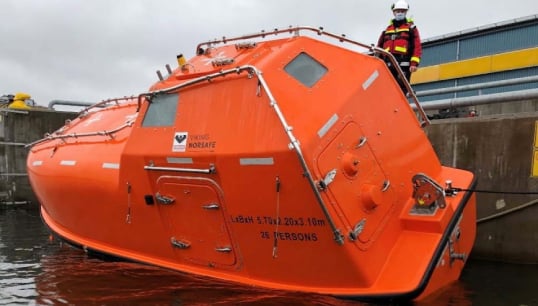Calls for action after lifeboat abandoned during training exercise
23 September 2022

Calls for European and international action to tackle survival craft safety have been made following an incident in which an enclosed lifeboat heeled over during a training exercise.
The enclosed lifeboat – which was also approved for use as a rescue boat – had to be abandoned when it began to list heavily and became flooded with water through an open side hatch.
Investigators warned that while the craft complied with applicable stability requirements, lifeboats of that type could – in certain conditions, and especially when loaded with a few people – be prone to taking on water and heeling over.
In a report on the incident, Sweden's Accident Investigation Authority (SHK) calls for the EU to 'take necessary measures' to ensure that the requirements in respect of lifeboat stability are fit for purpose and do not constitute a risk to maritime safety.
It also recommends international action to develop guidance for the safe use of small, enclosed lifeboats with side openings near the gunwale and urges the manufacturers to revise the operation and maintenance manual for the lifeboat type.
The accident occurred in April 2021 at a training centre in Frihamnen harbour, Stockholm, while six merchant navy officers and an instructor were taking part in a refresher course session to practise rescuing survivors from the water using a lifeboat.
The 5.7m Viking-Norsafe JYN 57T craft – which had a 26-person capacity – heeled heavily to port and half filled with water during a change of helmsman. Three people were thrown into the water – which had a temperature of 5°C – while the others were able to cling to its sides until other rescue boats arrived.
'The accident was caused by the lifeboat’s stability properties, which meant that small changes in centre of gravity gave rise to large angles of heel,' SHK said.
'At system level, the accident was caused by insufficient stability requirements for small, enclosed lifeboats with side openings near the gunwale,' it added.
Investigators said tests had shown that small forces could generate large angles of heel, especially when a lifeboat is lightly loaded and has few people onboard.
Their report questions the adequacy of the International Life-Saving Appliance (LSA) Code, pointing to 'inconsistencies' in the format of the regulations. 'The stability requirements are designed for static conditions in calm water and there are no requirements in respect of dynamic forces or heavy weather,' it points out. 'The regulatory framework also fails to take into account the fact that each individual person on board a small lifeboat has significantly more impact on its stability, compared with a larger lifeboat.'
SHK said it was reasonable to assume that other lifeboats of similar types and sizes may have similar stability properties and it warned that the risks could be greatest when a craft is being used as a rescue boat.
'In a real situation, especially in heavy weather, there should be no doubt that a lifeboat has sufficient stability for the rescue tasks that may need to be performed, at least within reasonable limits,' the report concludes.
Tags
More articles
Nautilus concerned over Panama Canal flood
Nautilus has been concerned to see reports today (13 September) that the Panama Canal flooded at the Gatun locks.
Nautilus demands action from UK government six months on from P&O Ferries scandal
Nautilus International joins the Trades Union Congress in calling on the government, led by new Prime Minister Liz Truss, to hold P&O Ferries accountable for their unlawful actions.
Nautilus shortlisted for two Mersey Maritime Awards
Nautilus International has been announced as a finalist in two categories at the Mersey Maritime Industry Awards 2022.
